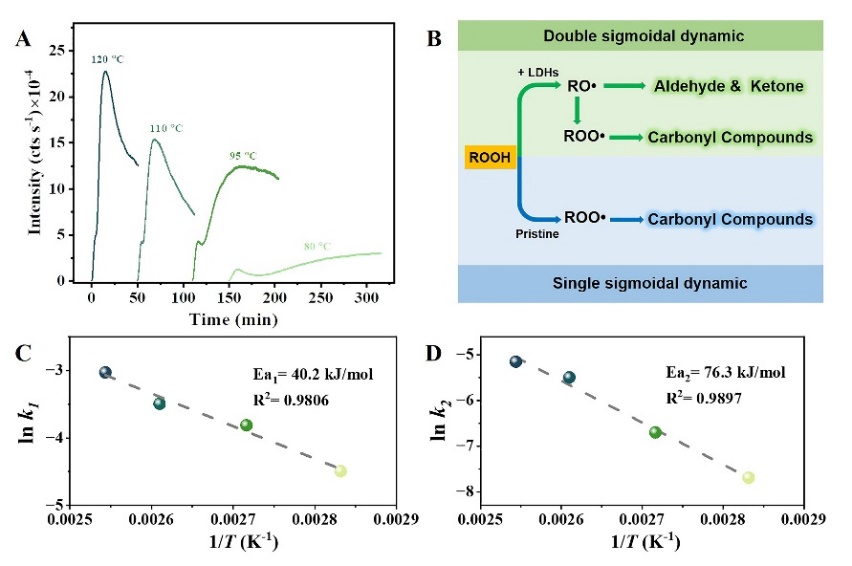
Polymer degradation has been regarded as a critical issue accompanied with the sustainable growth in the demand and manufacturing of polymers. Hydroperoxide (ROOH) as the initial substance is apt to undergo unimolecular or bimolecular decomposition under thermal oxidative conditions and generate different radicals, generating alkoxy radicals (RO•) or peroxy radicals (ROO•). Accordingly, different degradation pathways were triggered, leading to the termination or acceleration of polymer degradation. Therefore, it is of critically important to monitor and regulate of radicals during the degradation process of polymers. Currently, electron spin resonance (ESR) is generally implemented to study various radicals. However, it is a long-standing challenge to study radical behaviours owing to the ultra-short lifetime of the transient radicals generated during the polymer degradation.
To solve this problem, Prof. Chao Lu’s group proposed a radical-trigged luminescence approach to achieve the monitoring of polymer degradation pathway, and the degradation process were regulated through two-dimensional layered double hydroxides (LDHs).

Taking polyethylene (PE) as example, the isothermal luminescence dynamic curves of PE recorded during the thermal oxidation degradation showed a single sigmoidal shape. Upon the addition of MgAl-LDHs, the PE@x%MgAl-LDH composites exhibited a double sigmoidal shape luminescence dynamic curve. The intensities of two luminescence peaks increased with the increase amounts of MgAl-LDHs.

The nonisothermal luminescence dynamic curves for PE during thermal oxidation process were studied. It was found that the first luminescence peak of PE@x%MgAl-LDH composites corresponded to the generation of RO•, producing aldehydes and ketones. The second luminescence peak was derived from ROO•, leading to the generation of carbonyl compounds. These results were consistent with in-situ IR and ESR signals. Further results showed that the degradation pathways to generate ROO• could be transformed to the formation of RO• due to the stabilization of ROOH by the positively charged MgAl-LDHs. Accordingly, the degradation of polymers could be inhibited effectively.

These results have not only provided a new approach for the monitoring of radicals in the degradation process, but also deepened the understanding of the radical mechanisms during polymer degradation. Our findings would become a solid foundation for regulating aging pathways and the rational design of anti-degradation polymers.
Information:
Regulating Degradation Pathways of Polymers by Radical-Triggered Luminescence
The first author is Yue Hou, and the corresponding author are Prof. Dr. Rui Tian and Prof. Dr. Chao Lu.
Angewandte Chemie International Edition DOI:10.1002/anie.202307573
